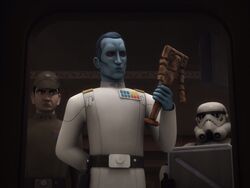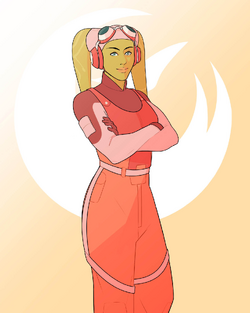- Numa: "A totem passed down the line of a Twi'lek family. It honors all who have come before."
- Gobi Glie: "Each parent adds to the artwork to include themselves in the legacy."
- Sabine Wren: "Hmm. Family history as living art."
- ―Numa, Gobi Glie, and Sabine Wren talk about the Kalikori[1]
The Kalikori was a revered Twi'lek heirloom passed from parent to child through generations. According to tradition, each parent of a Twi'lek lineage made additions to the artwork to include themselves in the family legacy. Though materially worthless to outsiders, it was regarded as priceless to the family to whom it belonged. During the Imperial occupation of Ryloth in 2 BBY, Grand Admiral Thrawn acquired the Kalikori of the Syndulla clan, and members of the Ghost crew allied with Twi'lek rebels in an effort to reclaim it. Two years later, Hera Syndulla added the late Kanan Jarrus to her Kalikori to honor his sacrifice in returning it to her.
Description[]
Kalikoris were traditional totems belonging to Twi'lek families which would be passed down from generation to generation. They were shaped to be reminiscent of the species' two lekku, and each generation would add their own designs which denoted the family's history.[3] Regarded as a sacred heirloom among the Twi'lek culture, the Kalikori was a way to artistically represent family lineage and honor each clan's ancestors.[1]
The heirloom was a relatively small, hand-held object constructed of various materials. It was segmented into multiple smaller sections linked together with smaller beads, which acted as connection pieces.[1] Each segment was inscribed with different collections of colorful symbols, each representing important individuals in a Twi'lek family clan.[4] New additions to the Kalikori could be applied by either artistically adding a new design to a section, or by linking a new segment to the connection pieces.[5]
History[]
Mission to Ryloth[]
- "Hera would have inherited our family's Kalikori."
"And I still will. That heirloom was important to my mother. And I'm not ready to give it up yet." - ―Cham and Hera Syndulla
In 2 BBY,[6] Hera Syndulla met with her father, Cham, on her homeworld of Ryloth during the planet's Imperial occupation. Upon discovering that Imperial troops occupied the Syndulla residence and had taken possession of their family's Kalikori, Hera vowed to recover it. When the Spectres asked about the Kalikori, freedom fighters Gobi Glie and Numa explained its importance in the Twi'lek culture as a way to symbolically honor a clan's ancestors.[1]

Despite the rebels' attempts to recover it, Thrawn retained possession of the Kalikori.
In an effort to retrieve the Kalikori, Hera and Ezra Bridger entered the Syndulla residence under a disguise, while the remaining Ghost crew and Twi'lek rebels created a diversion in a nearby canyon. Although Hera and Bridger found the Kalikori, their escape was thwarted by the arrival of Grand Admiral Thrawn and Captain Slavin. She attempted to maintain her cover as a Twi'lek slave, but Thrawn quickly discovered Hera's true identity, imprisoning her and Bridger. When an undercover Chopper found where they were being held, Hera told him to place charges throughout the residence.[1]
At his order, the Kalikori was delivered to Thrawn's command ship. Hera and Bridger were brought to the courtyard of the Syndulla residence to perform a prisoner exchange with Cham, who had intended to sacrifice his freedom for his daughter's safety. However, Chopper ignited the explosives, and the rebels escaped aboard the Ghost as the residence was destroyed. Hera regretted their failure to acquire her Kalikori from the Empire, but she acknowledged the family she had found in both her father and the Spectres.[1]
Thrawn's collection[]

Hera Syndulla's family Kalikori was returned to her
Some time later, Imperial forces subjected Lothal to military occupation, using the planet as a base of operations. Alongside an Imperial factory, Grand Admiral Thrawn established an office, which he utilized to plan strategic moves against the Rebellion. The office housed a number of rebel artifacts he had gathered from various worlds,[7] including the Syndulla clan's Kalikori he had acquired from his time on Ryloth.[8] Thrawn often spent time studying the stolen artwork in an effort to gather clues about the rebels.[7]
The Kalikori, along with other artifacts, was transferred to Thrawn's office aboard his command ship, the Chimaera. In 2 BBY, members of Phoenix Cell launched a mission to extract Imperial Agent Alexsandr Kallus, whose identity as the rebel spy, Fulcrum, grew dangerously close to being revealed by Thrawn. While sneaking undercover into Thrawn's office, Bridger spotted the Kalikori on display, but Kallus discouraged his instinct to recover it for Hera.[9]
Thrawn left it in his office at the Imperial Complex following his interrogation of General Hera Syndulla. Jarrus retrieved it and returned to Hera.[4] In 1 BBY,[6] following Kanan Jarrus' death, on the recommendation of Chopper, Hera added Jarrus to her Kalikori. With this act of adding a new piece to the Kalikori, Hera made Kanan a member of the Syndulla family.[5]
Behind the scenes[]
"Kalikori" is a word that first appeared in the 2011 Star Wars Legends video game Star Wars: The Old Republic as the Kalikori village, a Twi'lek settlement on the planet Tython.[10][11] According to the in-game codex, the village was named after an old Twi'leki word for "beginning."[12]
Appearances[]
 Andor — "Aldhani"
Andor — "Aldhani" Andor — "Announcement"
Andor — "Announcement" Andor — "One Way Out"
Andor — "One Way Out" Star Wars Rebels — "Hera's Heroes" (First appearance)
Star Wars Rebels — "Hera's Heroes" (First appearance) Star Wars Rebels — "An Inside Man"
Star Wars Rebels — "An Inside Man" Star Wars Rebels — "Through Imperial Eyes"
Star Wars Rebels — "Through Imperial Eyes"- Thrawn: Alliances (Mentioned only)
- Thrawn: Alliances audiobook (Mentioned only)
 Star Wars Rebels — "Jedi Night"
Star Wars Rebels — "Jedi Night" Star Wars Rebels — "DUME"
Star Wars Rebels — "DUME"- Doctor Aphra (2016) 35
 Star Wars: Galaxy's Edge — Dok-Ondar's Den of Antiquities
Star Wars: Galaxy's Edge — Dok-Ondar's Den of Antiquities- Halcyon Legacy 4 (In flashback(s))
- Star Wars: Galaxy of Heroes
Non-canon appearances[]
Sources[]
 Face to Face with Thrawn | Star Wars Rebels on the official Star Wars YouTube channel (backup link) (Posted on StarWars.com)
Face to Face with Thrawn | Star Wars Rebels on the official Star Wars YouTube channel (backup link) (Posted on StarWars.com) The Menace of Thrawn - Hera's Heroes Preview | Star Wars Rebels on the official Star Wars YouTube channel (backup link) (Posted on StarWars.com)
The Menace of Thrawn - Hera's Heroes Preview | Star Wars Rebels on the official Star Wars YouTube channel (backup link) (Posted on StarWars.com) "Hera's Heroes" Episode Guide on StarWars.com (backup link)
"Hera's Heroes" Episode Guide on StarWars.com (backup link) "An Inside Man" Episode Guide | Star Wars Rebels on StarWars.com (backup link)
"An Inside Man" Episode Guide | Star Wars Rebels on StarWars.com (backup link)- Star Wars: The Visual Encyclopedia
 Star Wars: Destiny — Way of the Force (Card: Art of War) (backup link) (Picture only)
Star Wars: Destiny — Way of the Force (Card: Art of War) (backup link) (Picture only) Star Wars Helmet Collection 70 (Weapons & Uniforms: Grand Admiral Thrawn)
Star Wars Helmet Collection 70 (Weapons & Uniforms: Grand Admiral Thrawn)- Star Wars: Alien Archive
- The Star Wars Book
 Star Wars Inside Intel: Twi'lek Culture on StarWars.com (article) (backup link)
Star Wars Inside Intel: Twi'lek Culture on StarWars.com (article) (backup link) "Aldhani" Episode Guide | Andor on StarWars.com (backup link)
"Aldhani" Episode Guide | Andor on StarWars.com (backup link) Andor Actor Genevieve O'Reilly on the Legacy of Mon Mothma on StarWars.com (backup link) (Picture only)
Andor Actor Genevieve O'Reilly on the Legacy of Mon Mothma on StarWars.com (backup link) (Picture only) This Week! in Star Wars Tales of the Jedi Poster Art, Mon Mothma Arrives in Andor, and More! on the official Star Wars YouTube channel (backup link) (Posted on StarWars.com)
This Week! in Star Wars Tales of the Jedi Poster Art, Mon Mothma Arrives in Andor, and More! on the official Star Wars YouTube channel (backup link) (Posted on StarWars.com) Andor: 10 Easter Eggs We Found in Luthen's Gallery on StarWars.com (backup link) (Picture only)
Andor: 10 Easter Eggs We Found in Luthen's Gallery on StarWars.com (backup link) (Picture only)- Star Wars: Timelines
 "Day Wanna Wanga - The Tale of the Twi'leks" — Star Wars Insider 219
"Day Wanna Wanga - The Tale of the Twi'leks" — Star Wars Insider 219- Star Wars: Dawn of Rebellion: The Visual Guide
 5 Behind-the-Pages Secrets of Star Wars: Dawn of Rebellion on StarWars.com (backup link)
5 Behind-the-Pages Secrets of Star Wars: Dawn of Rebellion on StarWars.com (backup link) Grand Admiral Thrawn in the Databank (backup link)
Grand Admiral Thrawn in the Databank (backup link) Hera Syndulla in the Databank (backup link)
Hera Syndulla in the Databank (backup link) Kalikori in the Databank (backup link)
Kalikori in the Databank (backup link)
Notes and references[]
- ↑ 1.00 1.01 1.02 1.03 1.04 1.05 1.06 1.07 1.08 1.09 1.10 1.11 1.12 1.13 1.14
 Star Wars Rebels — "Hera's Heroes"
Star Wars Rebels — "Hera's Heroes"
- ↑ Star Wars: Alien Archive
- ↑
 Star Wars Inside Intel: Twi'lek Culture on StarWars.com (article) (backup link)
Star Wars Inside Intel: Twi'lek Culture on StarWars.com (article) (backup link)
- ↑ 4.0 4.1
 Star Wars Rebels — "Jedi Night"
Star Wars Rebels — "Jedi Night"
- ↑ 5.0 5.1
 Star Wars Rebels — "DUME"
Star Wars Rebels — "DUME"
- ↑ 6.0 6.1 Star Wars: Timelines
- ↑ 7.0 7.1
 Thrawn's Office in the Databank (backup link)
Thrawn's Office in the Databank (backup link)
- ↑
 Star Wars Rebels — "An Inside Man"
Star Wars Rebels — "An Inside Man"
- ↑
 Star Wars Rebels — "Through Imperial Eyes"
Star Wars Rebels — "Through Imperial Eyes"
- ↑ Star Wars: The Old Republic
- ↑
Pablo Hidalgo (@pablohidalgo) on Twitter: "I can't recall where that came from. It was so long ago! (My suspicions are that it was @HGilroy67's doing)" (content obsolete and backup link not available)
- ↑
 Star Wars: The Old Republic — Codex: "Jedi Temple (Tython)"
Star Wars: The Old Republic — Codex: "Jedi Temple (Tython)"

